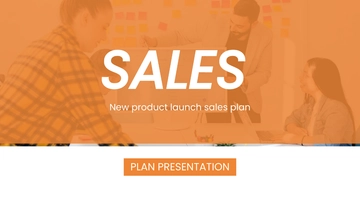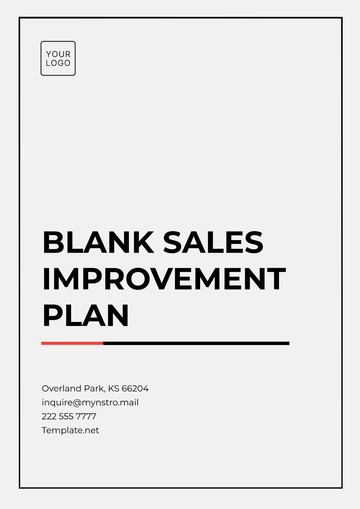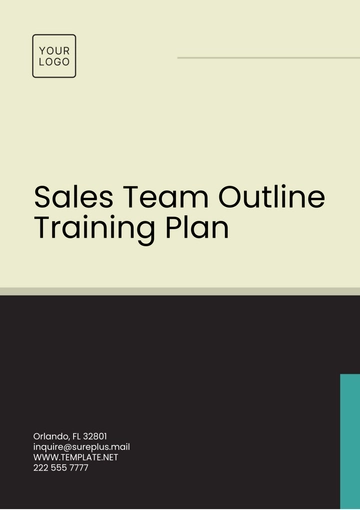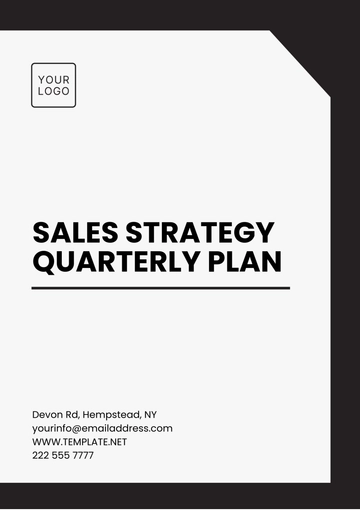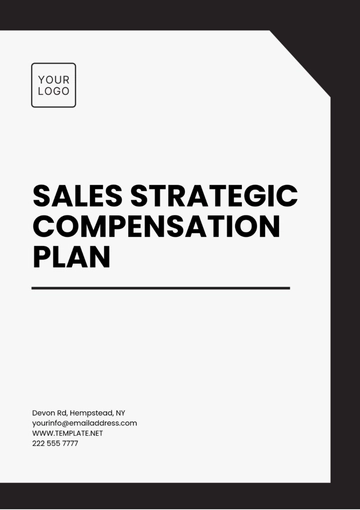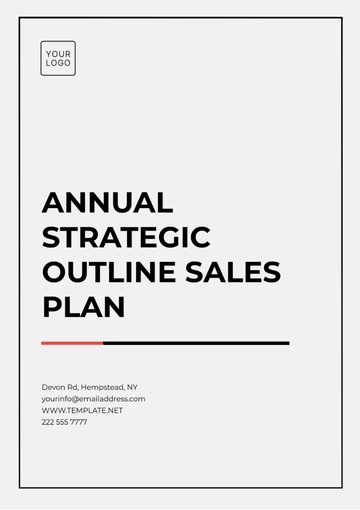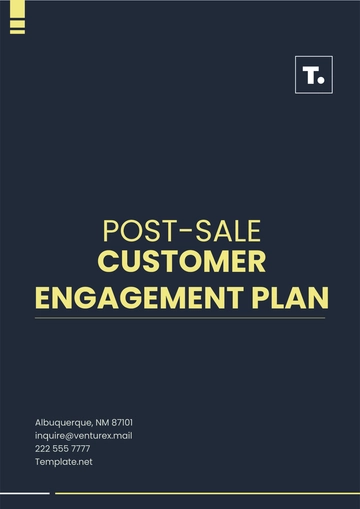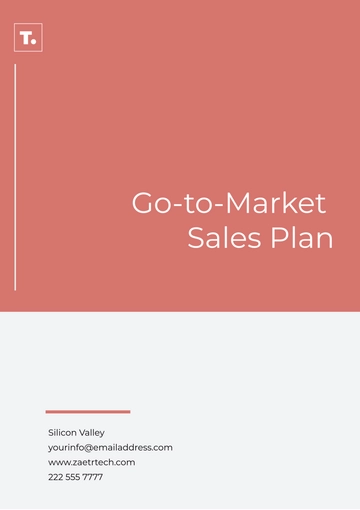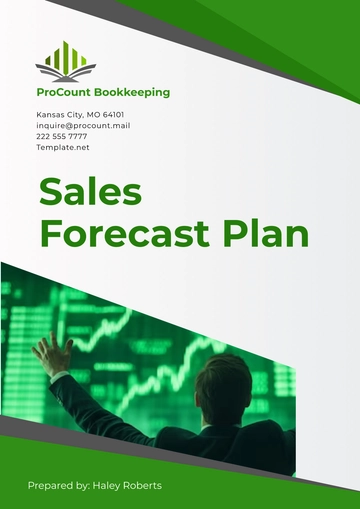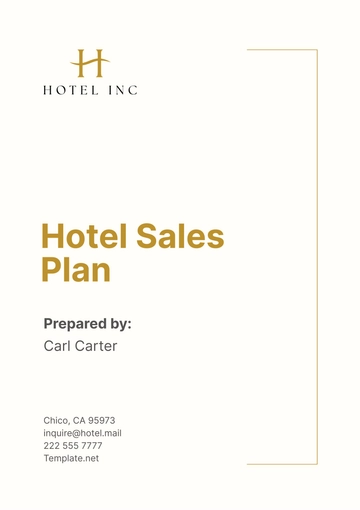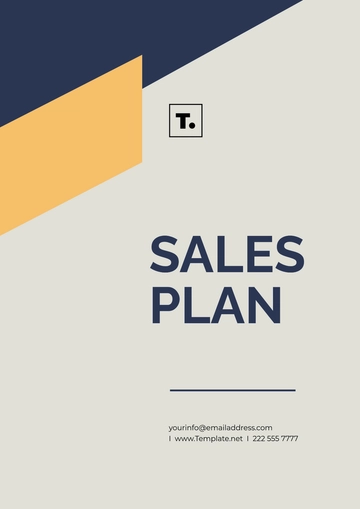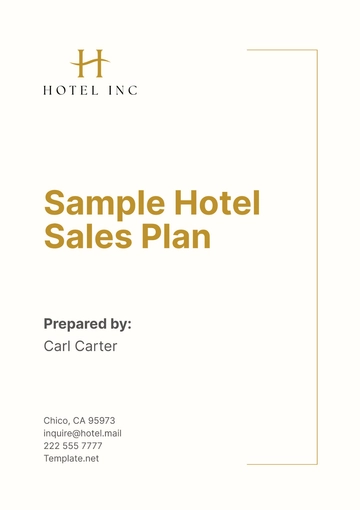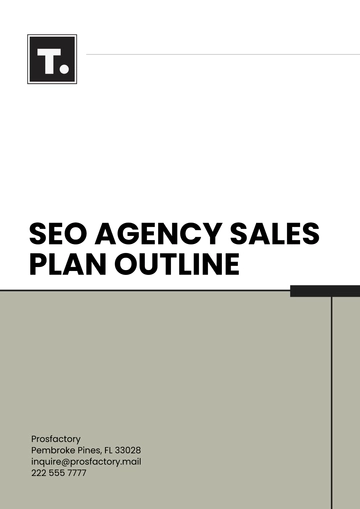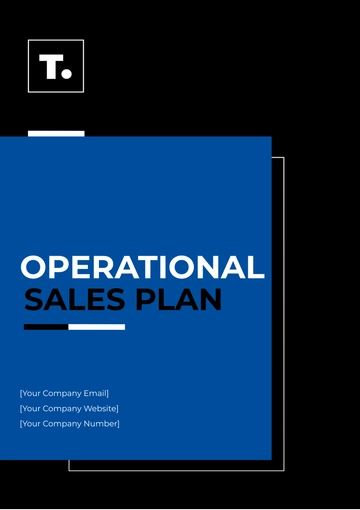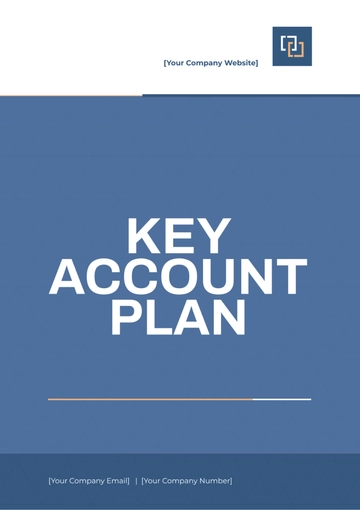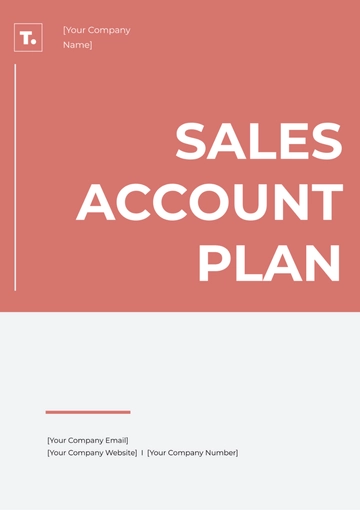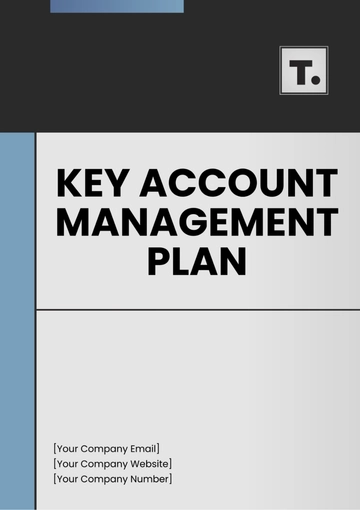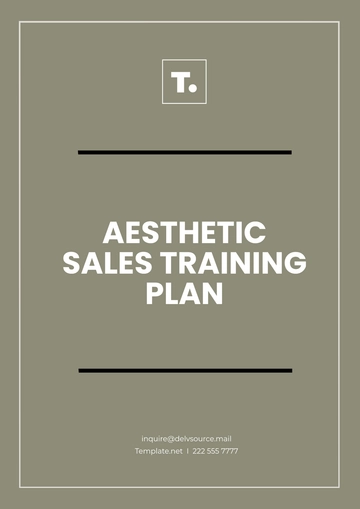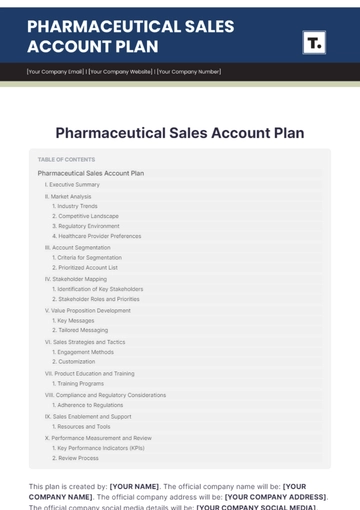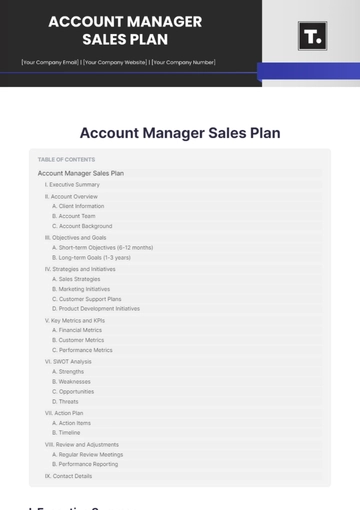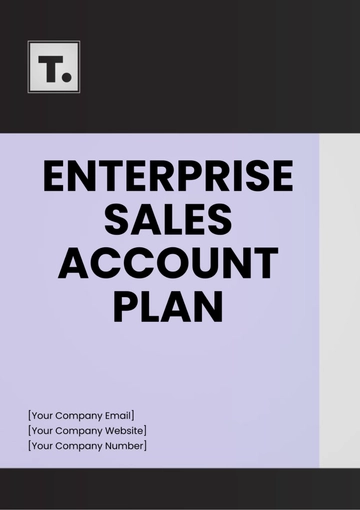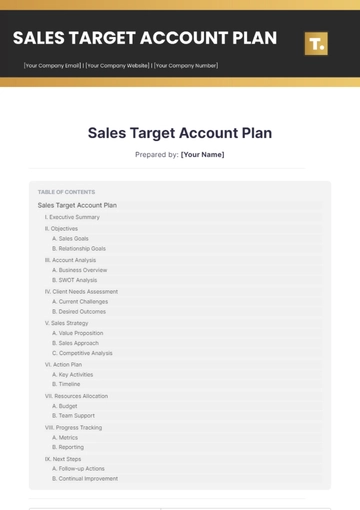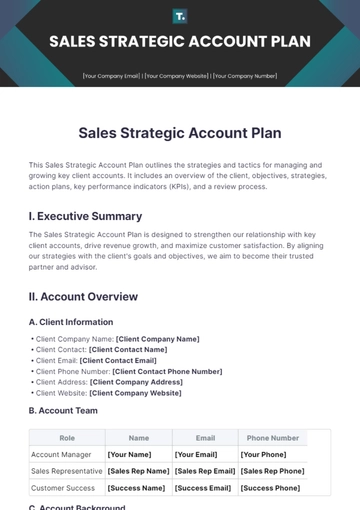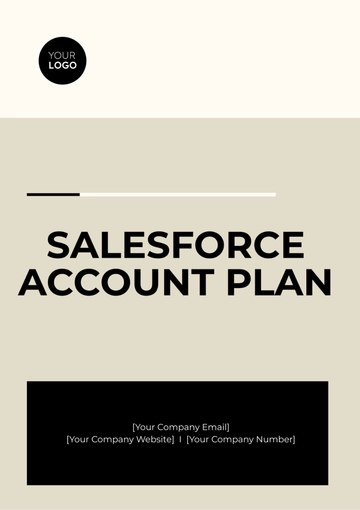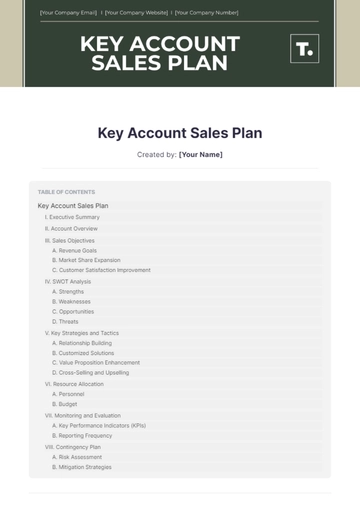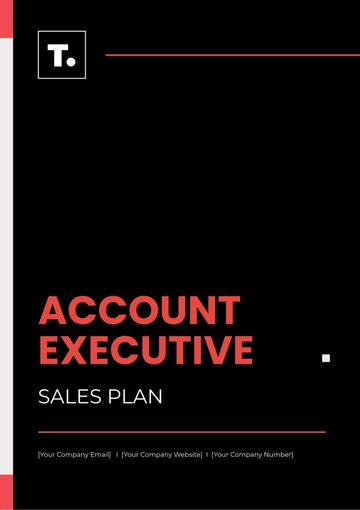Free Quarterly Sales Plan
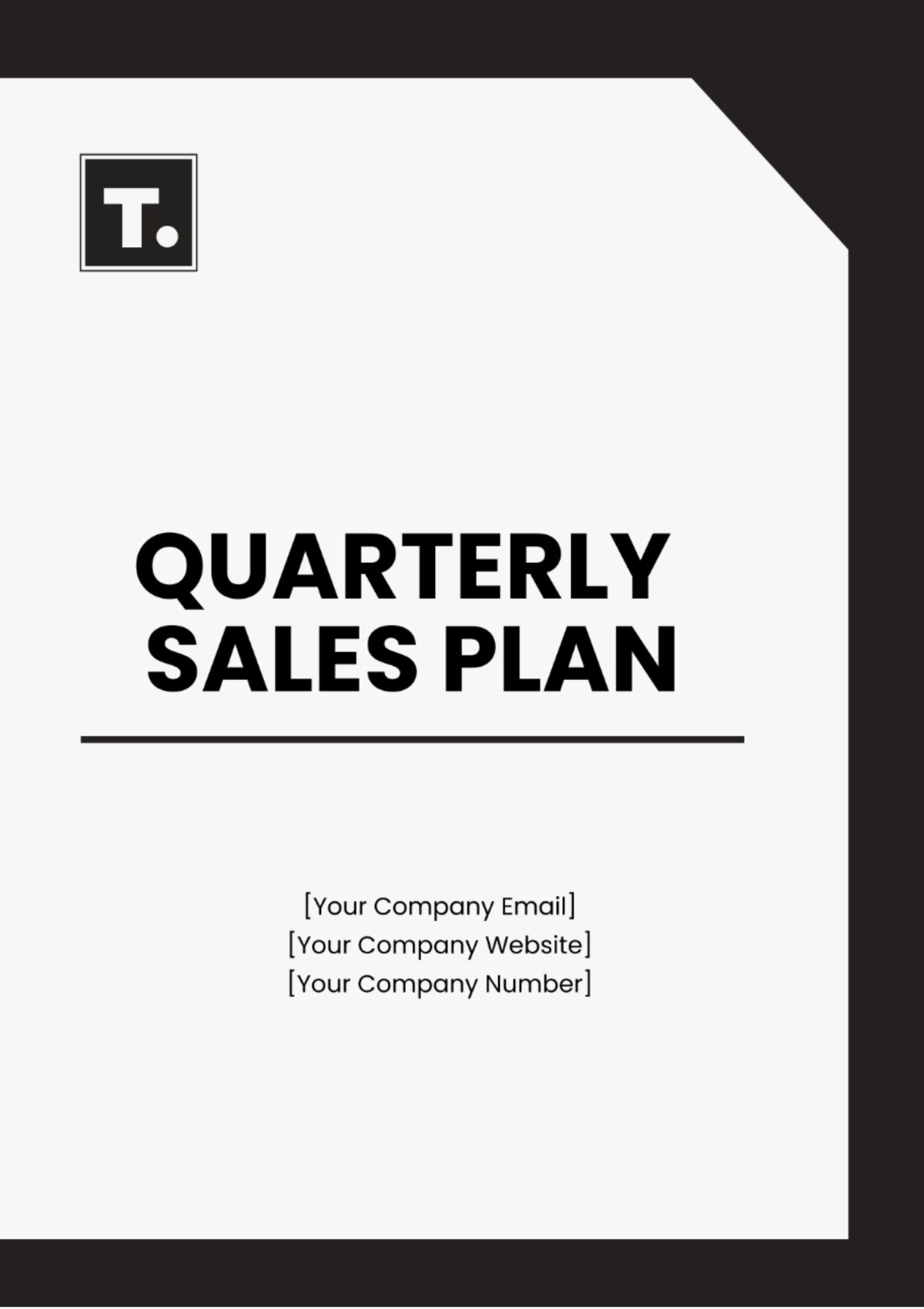
Prepared By: | [Your Name] |
Department: | [Your Department] |
Date: | [Date] |
I. Executive Summary
This Quarterly Sales Plan aims to outline the strategic goals, actionable tactics, and measurable objectives for [Your Company Name] to achieve within the upcoming quarter. The plan serves as a roadmap to align the sales team's efforts with the company's overall business objectives, ensuring that we not only meet but exceed our sales targets.
II. Specific Goals
A. Sales Revenue Targets
Target Revenue:
Quarterly Target Revenue: $1,000,000
Monthly Revenue Target:
Monthly Target = Quarterly Target Revenue / 3
Monthly Target = $1,000,000 / 3 = $333,333 (rounded)
Weekly Revenue Target:
Assuming a month has approximately 4 weeks:
Weekly Target = Monthly Target / 4
Weekly Target = $333,333 / 4 = $83,333 (rounded)
B. New Customer Acquisition
Define the Number of New Customers:
Analyze past acquisition rates and market potential to set a realistic quarterly target for new customers.
Use data analytics and market research to gauge the feasibility of acquiring new customers within the timeframe.
Segmentation and Targeting:
Identify customer segments aligned with your offerings using demographic, psychographic, and behavioral data.
Tailor marketing and sales efforts to target these segments effectively for personalized engagement.
Marketing Strategies:
Utilize targeted digital marketing campaigns (Google Ads, social media ads) and inbound strategies (content marketing, webinars) to reach potential customers.
Implement lead-generation tactics like gated content, landing pages, and email campaigns to capture and nurture leads.
Sales Outreach and Conversion:
Develop structured sales prospecting methods (cold calling, email outreach) and equip sales teams with persuasive collateral and promotions to drive conversions.
Focus on providing a seamless customer experience from onboarding to post-sales support to enhance satisfaction and retention rates.
Analytics and Optimization:
Use analytics tools to track acquisition performance, CAC, and ROI.
Optimize campaigns based on data insights, A/B testing, and customer feedback to improve acquisition efficiency.
C. Customer Retention
Set Retention Percentage Goal: Set a specific retention goal to increase from 75% to 85%, based on industry norms and aligning with company growth objectives.
Enhanced Customer Service: Train teams in proactive, empathetic service and implement CRM tools for personalized interactions and efficient issue resolution, fostering long-term customer relationships.
Engagement Strategies: Develop personalized communication like newsletters, loyalty programs, and exclusive offers to encourage repeat business and customer loyalty.
Regular Feedback Loops: Regular surveys and feedback analytics provide insights for improving overall customer experience, leading to higher satisfaction and retention rates.
Proactive Problem Resolution: Implement swift issue resolution processes and empower teams to address customer concerns promptly, showcasing dedication to customer satisfaction.
Value-added Services: Offer additional services based on customer preferences and provide educational resources to maximize customer benefits and reinforce brand loyalty.
Community Building: Create platforms for customer interaction, encourage user-generated content, and host events to build a sense of community and trust, enhancing retention and brand advocacy.
III. Market Analysis
A. Industry Overview
Market Trends: Identify tech advancements, consumer shifts, and regulations impacting your industry. For instance, sustainability trends in fashion are due to environmental awareness.
Growth Opportunities: Highlight untapped markets, new offerings, or emerging segments. Entering smartphone-heavy international markets for mobile apps.
Potential Challenges: Assess competition, supply chains, or economic shifts. Increased manufacturing costs impacting margins.
Competitive Landscape: Identify competitors, strengths, weaknesses, and differentiation strategies. Analyzing AI use in retail for better customer experiences.
Regulatory Environment: Understand compliance needs and impacts. Adhering to data privacy laws for customer data handling.
Consumer Behavior: Analyze buying habits to refine sales strategies. Rise in online shopping post-pandemic affecting retail strategies.
Technology Disruption: Evaluate tech impacts on business models. Blockchain in supply chains for transparency.
Market Segmentation: Define target markets for tailored marketing. Healthcare segmentation for personalized services.
B. Competitive Analysis
Key Competitors | Strengths | Weaknesses |
|---|---|---|
XYZ Corp | Strong brand presence, diverse product range | Slower customer service response times |
ABC Inc. | Innovative technologies, agile customer support | Limited market reach outside urban areas |
DEF Solutions | Competitive pricing, scalable solutions | Lacking in brand recognition compared to larger competitors |
Differentiation Strategies
Innovation: Introduce AI-driven features for enhanced user experiences.
Customer Service: Implement 24/7 customer support with live chat and dedicated account managers.
Value Proposition: Offer premium add-on services bundled with core offerings for added value.
Market Segmentation: Target niche industries or emerging markets with specialized solutions tailored to their needs.
Partnerships: Collaborate with industry leaders or influencers to increase brand visibility and credibility.
Marketing: Launch targeted campaigns highlighting product reliability, customer testimonials, and cost efficiency.
C. Target Market
Demographics:
Age: 30-45 years
Gender: Male and Female
Income Level: Upper Middle to High Income ($70,000-$150,000 annually)
Education: Bachelor's degree and advanced degrees
Location: Urban areas and suburban neighborhoods in tech-centric cities across the US (Silicon Valley, Austin, Seattle).
Psychographics:
Lifestyle: Family-oriented, health-conscious, environmentally conscious.
Personality Traits: Innovative, socially responsible, goal-driven.
Values and Beliefs: Sustainability, diversity and inclusion, continuous learning.
Hobbies and Interests: Fitness and wellness, travel (especially eco-tourism), tech gadgets and innovations.
Behavioral Characteristics:
Buying Behavior: Prefer premium quality, eco-friendly products/services, value-driven purchases.
Usage Patterns: Heavy users of smart home technology, fitness apps, and social media for networking and research.
Brand Loyalty: Open to new brands that align with their values, influenced by expert recommendations and online reviews.
Feedback and Reviews: Actively engage in providing feedback, seek personalized experiences, and appreciate brands that listen and adapt.
IV. Strategic Approaches
A. Sales Strategies
Direct Sales:
Sales Team Focus: Train and empower your sales team to engage with prospects directly, understand their needs, and tailor solutions.
Relationship Building: Foster strong relationships with key clients through personalized interactions, follow-ups, and exceptional service.
Upselling and Cross-selling: Identify opportunities to upsell existing customers with complementary products/services and cross-sell to new segments.
Channel Sales:
Partnership Development: Collaborate with distributors, retailers, or online platforms to extend your reach and access new customer segments.
Channel Partner Training: Provide training and support to channel partners to ensure they represent your brand effectively and drive sales.
Incentives and Rewards: Implement incentive programs to motivate channel partners and drive sales performance.
Partnerships and Alliances:
Identify Strategic Partners: Identify and establish partnerships with complementary businesses or industry leaders to leverage each other's strengths and customer bases.
Joint Marketing Initiatives: Collaborate on marketing campaigns, events, or promotions to amplify brand visibility and attract new customers.
Co-selling Opportunities: Explore opportunities for joint sales efforts, bundled offerings, or referrals to drive mutual business growth.
B. Marketing Strategies
Email Marketing:
Segmented Campaigns: Segment your email lists based on customer demographics, behaviors, or interests for targeted campaigns.
Personalization: Personalize email content, recommendations, and offers based on customer data and past interactions.
Automation: Use marketing automation tools to schedule emails, trigger responses based on customer actions, and nurture leads through the sales funnel.
Social Media Campaigns:
Platform Selection: Identify key social media platforms (e.g., LinkedIn, Instagram, Twitter) based on your target audience demographics and engagement trends.
Engagement and Interaction: Foster engagement through interactive posts, user-generated content campaigns, contests, and polls.
Influencer Partnerships: Collaborate with influencers or industry experts to amplify brand reach, credibility, and engagement among their followers.
Content Marketing:
Content Creation: Develop high-quality and relevant content such as blogs, videos, infographics, and guides addressing customer pain points, industry trends, and product/service benefits.
SEO Optimization: Optimize content for search engines (SEO) to improve visibility and attract organic traffic to your website or landing pages.
Lead Generation: Use gated content (books, webinars) to capture leads, build email lists, and nurture prospects through targeted content sequences.
V. Actionable Tactics
A. Lead Generation:
Industry Events: Attend and participate in relevant industry events, trade shows, and conferences to network, showcase products/services, and generate leads.
Online Advertising: Utilize targeted online ads on platforms like Google Ads, social media ads (Facebook, LinkedIn), and industry-specific websites to reach potential leads.
Referral Programs: Incentivize existing customers or partners to refer new leads through referral rewards, discounts, or exclusive offers.
B. Sales Processes:
CRM Utilization: Implement and optimize Customer Relationship Management (CRM) software to track leads, manage customer interactions, and automate follow-ups.
Follow-up Mechanisms: Develop structured follow-up processes post-lead generation, including personalized emails, phone calls, and meetings to nurture leads.
Sales Funnel Management: Define and map out clear stages in your sales funnel, from lead generation to conversion, and implement strategies to move leads smoothly through each stage.
C. Customer Engagement:
Personalized Communication: Segment customer lists for personalized emails, messages, and offers based on their preferences, behaviors, and purchase history.
Loyalty Programs: Create loyalty programs with rewards, discounts, and VIP benefits for repeat customers, encouraging continued engagement and purchases.
Feedback Loops: Implement regular surveys, feedback forms, and reviews to gather insights, address customer concerns, and enhance overall customer experience.
VI. Sales Team Structure
Role | Name | Responsibilities |
|---|---|---|
Sales Manager | [Manager Name] | Oversee the entire sales team and strategy execution |
Sales Representative | [Rep Name 1] | Manage sales in designated territories |
Sales Representative | [Rep Name 2] | Develop and maintain relationships with clients |
Sales Representative | [Rep Name 3] | Identify new leads and opportunities |
Sales Representative | [Rep Name 4] | Conduct product demonstrations and presentations |
VII. Key Performance Indicators (KPIs)
KPI | Target Explanation |
|---|---|
Sales Revenue Target | Determine based on last quarter's revenue and growth goals. For example, $500,000 with a 10% increase to $550,000. |
New Customer Acquisition | Set based on historical rates and growth targets. For example, increase from 50 to 60 new customers this quarter. |
Customer Retention Rate | Improve from the current rate to the desired rate. For example, increase from 75% to 80% retention rate. |
VIII. Adaptability Strategies
Market Feedback: Collect and analyze customer feedback to refine sales strategies and product offerings.
Competitor Analysis: Monitor competitors to identify strengths, weaknesses, and opportunities for differentiation.
Internal Analytics: Use sales data and KPIs to optimize team performance and sales processes.
Review Meetings: Hold regular meetings to discuss progress, and challenges, and adjust strategies accordingly.
Flexibility: Stay agile by adapting sales tactics and promotions to meet evolving market and customer needs.
IX. Resource Allocation
Marketing Budget: Allocate $50,000 for digital campaigns, $20,000 for content creation, and $10,000 for event sponsorships.
Sales Tools Budget: Allocate $30,000 for CRM, $15,000 for sales training, and $10,000 for analytics tools.
Team Incentives Budget: Allocate $40,000 for quarterly bonuses, $15,000 for sales contests, and $5,000 for recognition programs.
- 100% Customizable, free editor
- Access 1 Million+ Templates, photo’s & graphics
- Download or share as a template
- Click and replace photos, graphics, text, backgrounds
- Resize, crop, AI write & more
- Access advanced editor
Plan your sales targets with Template.net's Quarterly Sales Plan Template. This fully customizable and editable template is perfect for setting and tracking quarterly goals. Editable in our AI Editor Tool, it allows you to personalize each detail. Stay on track and achieve your sales objectives with this practical and efficient template designed for sales success.
You may also like
- Finance Plan
- Construction Plan
- Sales Plan
- Development Plan
- Career Plan
- Budget Plan
- HR Plan
- Education Plan
- Transition Plan
- Work Plan
- Training Plan
- Communication Plan
- Operation Plan
- Health And Safety Plan
- Strategy Plan
- Professional Development Plan
- Advertising Plan
- Risk Management Plan
- Restaurant Plan
- School Plan
- Nursing Home Patient Care Plan
- Nursing Care Plan
- Plan Event
- Startup Plan
- Social Media Plan
- Staffing Plan
- Annual Plan
- Content Plan
- Payment Plan
- Implementation Plan
- Hotel Plan
- Workout Plan
- Accounting Plan
- Campaign Plan
- Essay Plan
- 30 60 90 Day Plan
- Research Plan
- Recruitment Plan
- 90 Day Plan
- Quarterly Plan
- Emergency Plan
- 5 Year Plan
- Gym Plan
- Personal Plan
- IT and Software Plan
- Treatment Plan
- Real Estate Plan
- Law Firm Plan
- Healthcare Plan
- Improvement Plan
- Media Plan
- 5 Year Business Plan
- Learning Plan
- Marketing Campaign Plan
- Travel Agency Plan
- Cleaning Services Plan
- Interior Design Plan
- Performance Plan
- PR Plan
- Birth Plan
- Life Plan
- SEO Plan
- Disaster Recovery Plan
- Continuity Plan
- Launch Plan
- Legal Plan
- Behavior Plan
- Performance Improvement Plan
- Salon Plan
- Security Plan
- Security Management Plan
- Employee Development Plan
- Quality Plan
- Service Improvement Plan
- Growth Plan
- Incident Response Plan
- Basketball Plan
- Emergency Action Plan
- Product Launch Plan
- Spa Plan
- Employee Training Plan
- Data Analysis Plan
- Employee Action Plan
- Territory Plan
- Audit Plan
- Classroom Plan
- Activity Plan
- Parenting Plan
- Care Plan
- Project Execution Plan
- Exercise Plan
- Internship Plan
- Software Development Plan
- Continuous Improvement Plan
- Leave Plan
- 90 Day Sales Plan
- Advertising Agency Plan
- Employee Transition Plan
- Smart Action Plan
- Workplace Safety Plan
- Behavior Change Plan
- Contingency Plan
- Continuity of Operations Plan
- Health Plan
- Quality Control Plan
- Self Plan
- Sports Development Plan
- Change Management Plan
- Ecommerce Plan
- Personal Financial Plan
- Process Improvement Plan
- 30-60-90 Day Sales Plan
- Crisis Management Plan
- Engagement Plan
- Execution Plan
- Pandemic Plan
- Quality Assurance Plan
- Service Continuity Plan
- Agile Project Plan
- Fundraising Plan
- Job Transition Plan
- Asset Maintenance Plan
- Maintenance Plan
- Software Test Plan
- Staff Training and Development Plan
- 3 Year Plan
- Brand Activation Plan
- Release Plan
- Resource Plan
- Risk Mitigation Plan
- Teacher Plan
- 30 60 90 Day Plan for New Manager
- Food Safety Plan
- Food Truck Plan
- Hiring Plan
- Quality Management Plan
- Wellness Plan
- Behavior Intervention Plan
- Bonus Plan
- Investment Plan
- Maternity Leave Plan
- Pandemic Response Plan
- Succession Planning
- Coaching Plan
- Configuration Management Plan
- Remote Work Plan
- Self Care Plan
- Teaching Plan
- 100-Day Plan
- HACCP Plan
- Student Plan
- Sustainability Plan
- 30 60 90 Day Plan for Interview
- Access Plan
- Site Specific Safety Plan
